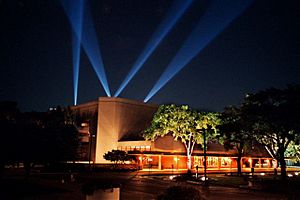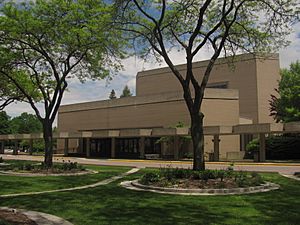Flint Cultural Center facts for kids
Quick facts for kids
Flint Cultural Center
|
|
|---|---|
|
campus
|
|

The campus of the Flint Cultural Center
|
|
| Country | USA |
| State | Michigan |
| County | Genesee |
| City | Flint |
| Area | |
| • Total | 13.37 ha (33.04 acre) |
The Flint Cultural Center (FCC) is a special campus in Flint, Michigan, USA. It's a place where you can explore art, science, and music all in one spot! Imagine a big park with many cool buildings.
On this campus, you'll find exciting places like the Flint Institute of Arts, the Flint Institute of Music, the Sloan Museum, and the Flint Public Library. There's also the Buick Gallery & Research Center, the Robert T. Longway Planetarium, The Whiting theater, and the Bower Theatre.
The campus is quite large, covering about 33 acres. A group called the Flint Cultural Center Corporation owns most of the land and some of the buildings. Other places, like the Flint Institute of Music and the Flint Institute of Arts, are independent. They rent their buildings from the Cultural Center.
Contents
History of the Cultural Center
How the Campus Started
Back in 1920, the City of Flint School District bought a large piece of land. Later, in 1946, a man named C.S. Mott had a great idea. He wanted to create a college campus in Flint. He even promised to help pay for a four-year college if people in Flint voted for a special bond issue. They did!
Mott also gave land for the new campus in the early 1950s. The first building, Ballenger Field House, was built in 1954. Soon after, in 1955, the Flint Community Junior College moved to the campus.
In the early 1950s, Michael A. Gorman, an editor at the Flint Journal newspaper, believed that people in Flint should have more chances to learn and experience culture. He and some friends formed a group to plan for Flint's future. This group helped create the "Committee of Sponsors for the Flint College and Cultural Development." They chose the Flint Board of Education to look after the new cultural campus.
The committee aimed to raise $25 million to start. General Motors gave $3 million to kick things off. Many people and companies also donated money. The Charles Stewart Mott Foundation also started giving its yearly gift to the Flint Cultural Center.
Michael Gorman passed away in 1958, but the cultural center buildings began to open that year. The last of the first buildings were finished in 1967. Many of them were named after important people in the car industry.
Running the Center
In 1973, the Sloan Museum started its yearly Sloan Auto Fair, a fun event for car lovers. The Committee of Sponsors kept raising money for many years.
In 1992, the Flint Cultural Center Corporation was created. This new group took over managing the campus. It also became in charge of the Longway Planetarium, Sloan Museum, and The Whiting auditorium.
In 1995, a big fundraising effort collected over $33 million. A lot of this money was used to fix up The Whiting theater, which was finished in 1999. Some money also went into special funds to help the center in the future. In 2000, the Longway Planetarium and Bower Theatre were connected with new classrooms and rehearsal spaces.
Since 2010, the Charles Stewart Mott Foundation has given over $3 million each year to help the Cultural Center and its organizations.
In 2013, the Flint Cultural Center Corporation bought two buildings, the Sarvis Center and Central Kitchen, from the Flint Community Schools. In 2018, the Sloan Auto Fair moved to Genesee County Parks' Crossroads Village. This was because the Flint Institute of Arts was expanding.
Also in 2018, the center started planning for a new school. This school, called Flint Cultural Center Academy, would focus on arts and science for kids from kindergarten to 8th grade. It was expected to open in 2019.
Later in 2018, voters in Genesee County approved a special tax to support arts groups. Most of this money goes to the Flint Cultural Center's institutions. The Flint Institute of Music's youth theater group also changed its name to Flint Repertory Theatre. It became a professional theater, and the youth theater became part of its education program.
Flint Cultural Center Corporation
| Nonprofit corporation | |
| Founded | (1992) |
| Headquarters | |
|
Key people
|
|
| Revenue | $6 million (2014 budget) |
|
Number of employees
|
|
| Divisions |
|
The Flint Cultural Center Corporation (FCCC) is a non-profit group that manages the Flint Cultural Center. It's in charge of running the Longway Planetarium, Sloan Museum, and The Whiting theater.
The FCCC was started in 1992. It took over managing the campus from the school district. It also became the main group for the Longway Planetarium, Sloan Museum, and Whiting Auditorium.
In 2003, the FCCC also took over the Flint Youth Theatre program. In 2004, most of the Cultural Center campus land was given to the FCCC. In 2013, the FCCC bought the Sarvis Center and Central Kitchen buildings. In 2018, the corporation started its own public charter school, the Flint Cultural Center Academy.
Sloan-Longway: Explore Science and Cars!
Sloan-Longway is a part of the Flint Cultural Center Corporation. It runs three cool places: the Alfred P. Sloan Museum, the Robert T. Longway Planetarium, and the Buick Automotive Gallery and Research Center.
The Sloan Museum has an amazing collection of about 100 cars! Some of these cars are shown at the Sloan Museum, and others are at the Buick Automotive Gallery. Sloan-Longway was formed in 2004 to bring these operations together.
In 2012, the Flint Journal newspaper gave its old records and papers to the Sloan Museum. These important historical documents are kept at the museum's Perry Archives in the Buick Gallery building.
Since 2010, money has been raised for a special portable dome theater. This means planetarium shows can be brought right to local schools! The Portable Dome Theater was bought in 2013.
The Whiting: A Place for Performances
The Whiting is another part of the Flint Cultural Center Corporation. It manages The Whiting auditorium and the Capitol Theatre downtown.
In 1993, The Whiting auditorium started its "Showcase Series" with five performances. By 2008, this series, now called the "Spotlight Series," had grown to 27 shows! The Whiting auditorium was also renovated and improved between 1997 and 1999.
In 2015, a group bought the downtown Capitol Theatre. They partnered with The Whiting to restore the old theater. The Whiting now manages its shows and events. The Capitol Theatre reopened its doors on December 7, 2017.
Buildings on Campus
Here are some of the main buildings you'll find at the Flint Cultural Center:
- Original Buildings (built between 1958 and 1967)
- F.A. Bower Theater: A place for performances.
- Flint Institute of Arts: This art museum was once called the Enos A. and Sarah DeWaters Art Center. It has been updated thanks to fundraising.
- J. Dallas Dort Music Center: Home to musical learning and performances.
- Flint Public Library: A great place to find books and learn.
- Robert T. Longway Planetarium: This building was built for $600,000. It opened its doors on June 29, 1958. Its unique dome was designed by the famous inventor Buckminster Fuller. Between 1999 and 2000, it was expanded and connected to the Bower Theater. It got a new lobby, a science classroom, and updated equipment.
- Sarvis Conference Center: This building is named after Arthur H. Sarvis. It was owned by the Flint Community Schools until 2013, when the FCCC bought it.
- Alfred P. Sloan Museum: Named after a former president of General Motors. This museum opened in November 1966. It closed temporarily in December 2018 for big renovations and to make it larger.
- The Whiting: This theater was once called the James H. Whiting Auditorium. It was renovated between 1997 and 1999 to make it even better.
- Additional Buildings
- Buick Automotive Gallery and Research Center: This building used to display many classic cars. It closed in 2018 for repairs, and the cars were moved to a mall for a while.
- Central Kitchen: This building was also owned by the Flint Community Schools until the FCCC bought it in 2013.
- Flint Cultural Center Academy: A new K-8 charter school that opened in 2019.





